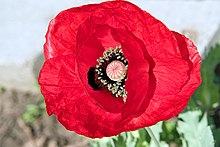| Papaver glaucum | |
|---|---|

| |
| Scientific classification | |
| Kingdom: | Plantae |
| Clade: | Tracheophytes |
| Clade: | Angiosperms |
| Clade: | Eudicots |
| Order: | Ranunculales |
| Family: | Papaveraceae |
| Genus: | Papaver |
| Species: | P. glaucum |
| Binomial name | |
| Papaver glaucum Boiss. & Hausskn. ex Boiss. | |
Papaver glaucum, the tulip poppy, Turkish tulip or Turkish red poppy, is a poppy found in the region of Anatolia.
Features
Growing to a height of 90 centimetres (35 in), this poppy withstands the droughts of non-Arab Middle East. The flowers are of rich red colours, with black spots in the centre. The thin petals may be crispy. The flowers bloom to a diameter of 10 cm (3.9 in). The inner petals stick up, which resembles a tulip. Looks similar to the corn rose poppy Papaver rhoeas and the Greek red poppy Papaver dubium. The distinct characteristics is the black centre which emphasises the tulip-shaped petals surrounding it.
Growing
As for all poppies, best time to be sown is late autumn or early spring. The snow of winter helps "challenge" the poppies to grow good rooting systems, which results in a strong plant. Spacing for plants should be at the minimum of 30 cm (12 in) because the roots do not grow deep, and after just a few centimetres they start growing horizontally. The disadvantage of their roots is that poppies do not do well being transplanted. Caution must be taken when transplanting from peat pots. Another problem with the roots of any type of poppy is that the roots will rot if they do not have proper drainage. One should not over water, and to prevent complications one must use a spray bottle when Papaver plants are maturing.
Chemical composition
The Turkish tulip contains the alkaloids morphine, codeine and thebaine. Nevertheless, its blossom and foliage are only used for ornamental purposes; the alkaloidal content of the narcotics stated are relatively low, thus uneconomic to extract opiates.
References
- "PLANTS Profile for Papaver glaucum (tulip poppy) | USDA PLANTS". Plants.usda.gov. Retrieved 2012-10-23.
- BSBI List 2007 (xls). Botanical Society of Britain and Ireland. Archived from the original (xls) on 2015-06-26. Retrieved 2014-10-17.
- NRCS. "Papaver glaucum". PLANTS Database. United States Department of Agriculture (USDA). Retrieved 30 January 2016.
- "Papaver glaucum "Tulip Poppy" Seeds". Seedaholic.com. Archived from the original on 2012-04-24. Retrieved 2012-10-23.
- "Papaver glaucum "Tulip Poppy" - Buy Online at Annie's Annuals & Perennials". Anniesannuals.com. Retrieved 2012-10-23.
- "Tulip poppy videos, photos and facts - Papaver glaucum". ARKive. Archived from the original on 2012-05-02. Retrieved 2012-10-23.
- "Papaver glaucum". Robsplants.com. Retrieved 2012-10-23.
- "Papaver dubium". Plant-identification.co.uk. 2006-07-04. Retrieved 2012-10-23.
- "The Leading Poppy Site on the Net". poppies.org. Retrieved 2012-10-23.
- "How to Grow Poppies". Mightyguide.net. 15 August 2011. Retrieved 2012-10-23.
- Salehi, Peyman; Sonboli, Ali; Zavareh, Alireza Fakhari; Sefidkon, Fatemeh; Dayeni, Manijeh; Cheraghi, Bahram (2007). "Narcotic Alkaloids of Four Papaver Species from Iran". Zeitschrift für Naturforschung C. 62 (1–2): 16–8. doi:10.1515/znc-2007-1-203. PMID 17425099. S2CID 24008266.
- "Papaver glaucum". Germplasm Resources Information Network. Agricultural Research Service, United States Department of Agriculture. Retrieved 2012-10-23.